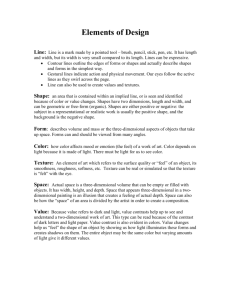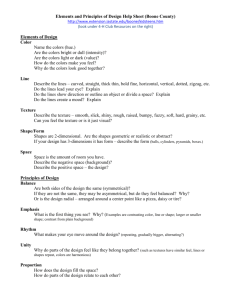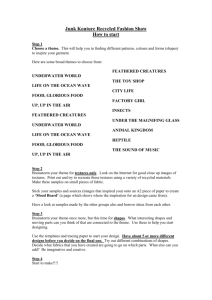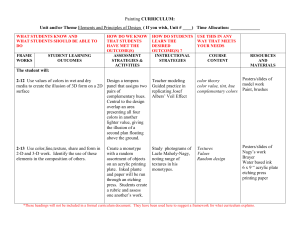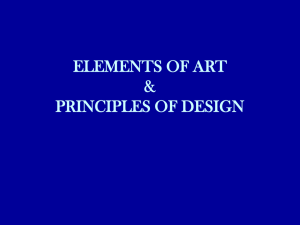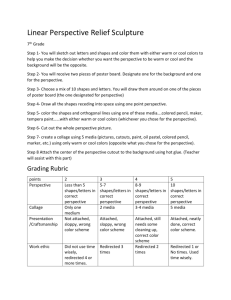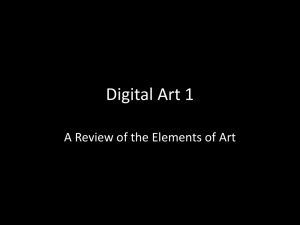Formal Visual Analysis: Elements & Principles
advertisement
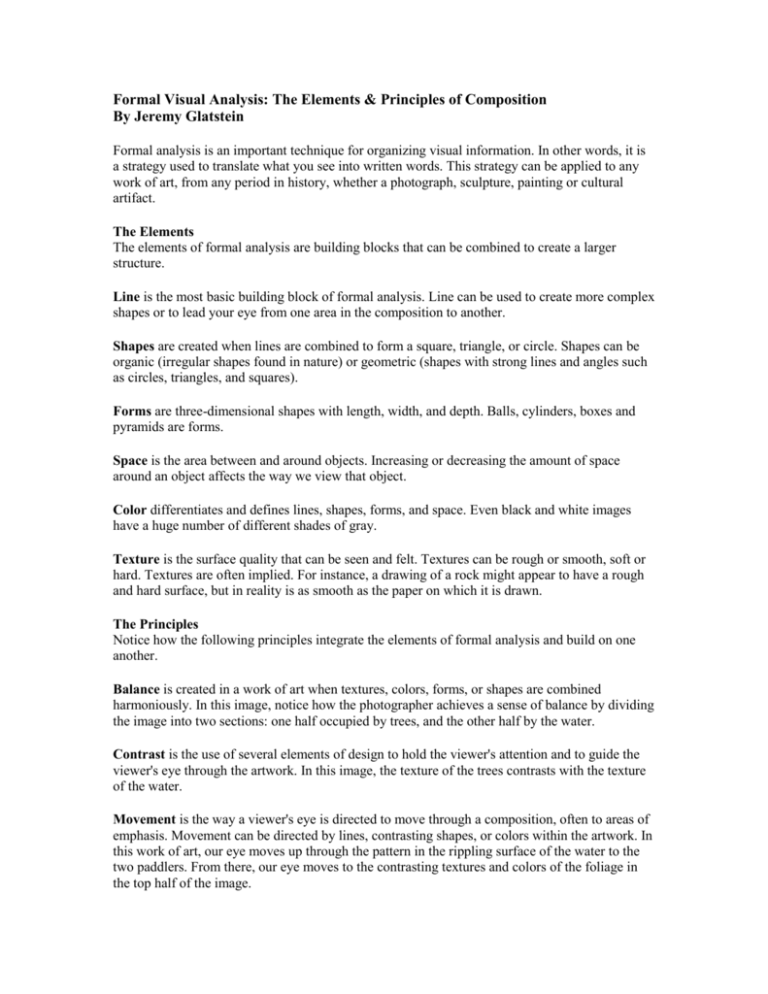
Formal Visual Analysis: The Elements & Principles of Composition By Jeremy Glatstein Formal analysis is an important technique for organizing visual information. In other words, it is a strategy used to translate what you see into written words. This strategy can be applied to any work of art, from any period in history, whether a photograph, sculpture, painting or cultural artifact. The Elements The elements of formal analysis are building blocks that can be combined to create a larger structure. Line is the most basic building block of formal analysis. Line can be used to create more complex shapes or to lead your eye from one area in the composition to another. Shapes are created when lines are combined to form a square, triangle, or circle. Shapes can be organic (irregular shapes found in nature) or geometric (shapes with strong lines and angles such as circles, triangles, and squares). Forms are three-dimensional shapes with length, width, and depth. Balls, cylinders, boxes and pyramids are forms. Space is the area between and around objects. Increasing or decreasing the amount of space around an object affects the way we view that object. Color differentiates and defines lines, shapes, forms, and space. Even black and white images have a huge number of different shades of gray. Texture is the surface quality that can be seen and felt. Textures can be rough or smooth, soft or hard. Textures are often implied. For instance, a drawing of a rock might appear to have a rough and hard surface, but in reality is as smooth as the paper on which it is drawn. The Principles Notice how the following principles integrate the elements of formal analysis and build on one another. Balance is created in a work of art when textures, colors, forms, or shapes are combined harmoniously. In this image, notice how the photographer achieves a sense of balance by dividing the image into two sections: one half occupied by trees, and the other half by the water. Contrast is the use of several elements of design to hold the viewer's attention and to guide the viewer's eye through the artwork. In this image, the texture of the trees contrasts with the texture of the water. Movement is the way a viewer's eye is directed to move through a composition, often to areas of emphasis. Movement can be directed by lines, contrasting shapes, or colors within the artwork. In this work of art, our eye moves up through the pattern in the rippling surface of the water to the two paddlers. From there, our eye moves to the contrasting textures and colors of the foliage in the top half of the image. Emphasis is created in a work of art when the artist contrasts colors, textures, or shapes to direct your viewing towards a particular part of the image. In this image, the colors of the paddlers' jackets contrasts with the muted tones of the background. Our attention is immediately drawn to the paddlers, even though they are relatively small in scale. Pattern is the repetition of a shape, form, or texture across a work of art. The light reflecting off of the waves in the water creates a pattern in the bottom half of the image. Proportion is created when the sizes of elements in a work of art are combined harmoniously. In this image, all of the proportions appear exactly as one would expect; the human figures are much smaller in scale than the natural world that surrounds them. Unity is created when the principles of analysis are present in a composition and in harmony. Some images have a complete sense of unity, while some artists deliberately avoid formal unity to create feelings of tension and anxiety. In this image, the large areas of contrasting textures, patterns and colors create a sense of balance and unity within the composition. Once students have an understanding of formal analysis, they will be well prepared to put this theory into practice by making their own images based on the elements and principles of design. Whether in photography, sculpture, or painting, the theory of formal analysis will help students to compose their works of art as professional artists would. In any work of art, all of these elements and principles will be present, but some will be more obvious than others. When engaging in formal analysis, students should select the elements they feel are most strongly represented in the piece they are analyzing. A good place to start formal analysis is to look at a work of art and take note of how your eye moves around the object. Where does your eye go first, and why were you attracted to that part of the image? What colors, textures, and shapes appear in the image? What did the artist include in the composition to guide your eye or to direct your gaze to a certain part of the image? ____________________________________________________ (Visual analysis: Gilchrist) Other principles apply to the content of the visual. Visual communication involves various types of visual elements (pie charts, bar graphs, as well as other ways of illustrating data or concepts). Representation with photos, however, can be loaded with other aspects that make it a powerful mode of communication. A few of these are the following. Representation and Association Visuals can be representational and can carry varied associations that are cultural, religious, or highly personal. In terms of representation, symbolism may exist that is well-worn: a rose or a heart representing love (a one-to-one representation). A small house with a picket fence out front, with a tire swing is sometimes still associated with a grand narrative of U.S. culture: “The American Dream.” The color red may symbolize love, heat, sin (Hawthorne’s The Scarlet Letter), embarrassment, or danger. Symbols can be used in different ways. For instance, literally: an American flag (symbol) flying beside of a Dodge truck can create a sense that any good American is being patriotic by buying the truck. Advertisers often use such associations, which in logic is, in this case, called “glory by association” and is a fallacy (i.e., just because a person buys a Dodge truck does not mean that person is a good American). But symbols may also be used with irony or satire. If a caption “The American Dream” were placed on the photo of a person who was homeless, retrieving food from a garbage bin, we would take it as a comment on the divide between the rich and poor in America, or, at any rate, that such a “Dream” was defunct — at least for part of the population. Some images may represent larger situations or ideologies, with its connotations and associations. A photo of “Ground Zero” in New York may suggest many things to a fire fighter, while it may suggest very different things to a terrorist. The photo of a person climbing the last steps to the summit of a high mountain may represent a sense of escape and freedom from the confines of industrialized society for one person, but may represent to another person the tenacity it takes to complete an arduous task. To yet another person such a photo may represent the superfluous things humans do when they could be working at something profitable. In viewing visual representations, then, people will carry to it various associations of their own. These may be associations from their childhood, their family life, or neighborhood. Associations are tied to environment and experiences, some shared, some private. When we communicate visually, we need to be aware of connotations and associations that people will have concerning what they see, even though it is unlikely we will be able to predict all responses to images we set before our audiences. Within your groups, a) assign a secretary to record what each person says and what is to be presented; b) discuss the photo assigned to your group, c) evaluate it for elements and principles of composition (list of elements and principles, above); d) discuss with your group issues of representation and association. You will need to decide how the group’s comments will be presented (with, say, the whole group speaking to the class — each point by a selected person — or all points by the recorder or by another person).
